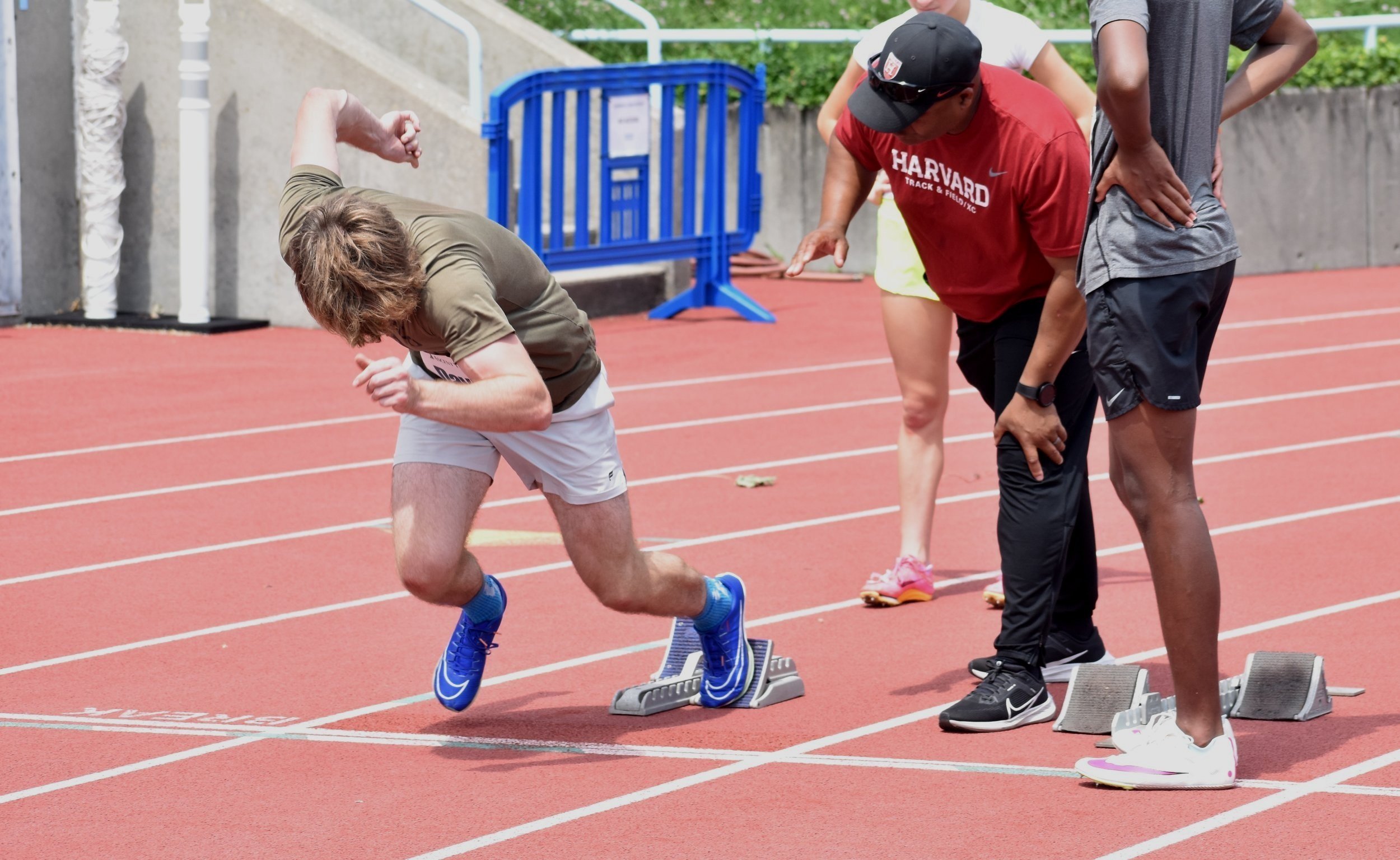
101. WEIGHT TRAINING FOR SPEED, POWER, AND SPORTS PERFORMANCE
Get step-by-step teaching progressions for the Olympic lifts, a weight training inventory of nearly 100 exercises, and guidance on sets, reps, intensities, and recoveries in this self-paced course led by veteran instructor and founder of USTFCCCA’s Track & Field Academy, Boo Schexnayder.
~6 Hrs. Duration | 35 Pages of Course Materials | 10 Knowledge Retention Checks
This course is also included in the Weight Room Bundle and the Strength and Conditioning Bundle.
Course instructor
BOO SCHEXNAYDER
Director, Consultant, Coach
SAC Speed
With over 40 years of experience in coaching and consulting, Boo Schexnayder is regarded as one of the world’s premier field event coaches.
He was the mastermind behind 26 NCAA Champions during his collegiate coaching career, was part 13 NCAA Championship teams and a pair of Juco National titles, and he has developed a host of conference champions and All-Americans.
Schexnayder has also been a prominent figure on the international scene. He has coached 18 Olympians and 7 Olympic/World Championship medalists, and served on coaching staffs for Team USA to the 2003 Pan Am Games in Santo Domingo, the 2006 World Junior Championships in Beijing, and was the Jumps Coach for Team USA at the 2008 Olympics in Beijing.
-
Schexnayder has been just as successful off the track. He is certified at Level I, II and III, and owns the prestigious Master Coach Designation from USA Track and Field. He is also certified by the NSCA as a Strength and Conditioning coach.
Schexnayder has been heavily involved in Coaching Education. He formerly served as national chair of USATF’s Coaching Education Committee, Jumps Subcommittee chair, and chair of the Biomechanics subcommittee.
Schexnayder was also the founder of the Track and Field Academy, the educational branch of the US Track and Field and Cross Country Coaches Association. He served as program director from its inception in 2009 through 2017, and still serves as an instructor in biomechanics, training design, and event-specific courses.
GET ACCESS:
COURSE DESCRIPTION
LEARN TO CREATE A SAFE AND EFFECTIVE WEIGHT TRAINING PROGRAM
In this comprehensive self-paced online course, instructor Boo Schexnayder…
Covers different types of strength and lifts.
Provides detailed, step-by-step teaching progressions for the Olympic Lifts and specific technique pointers for Squats, the Bench Press, and Split Position lifts.
Shares his entire weight training inventory, including Bodybuilding circuits and remedial exercises, nearly 100 in all.
Offers simple rules and guidelines for forming your program.
Shares advice on how to fit the weight training with training done outside the weight room.
Offers tips on sets, reps, intensities, and recoveries for all lifts at any time of year, and a phase-by-phase periodization model.
Shares his unique maxing out and testing system with you, designed for coaches, athletes, fitness enthusiasts, physical therapists, and athletic trainers.
This course features archived video content that can now only be found here in this course, while the study notes and knowledge retention checks are new materials that are unique to this course.
GET ACCESS:
COURSE LAYOUT
01. TYPES OF STRENGTH
This chapter introduces the three primary types of strength—absolute strength, power, and reactive strength—outlining their roles in athletic performance and specific training methods required for each.
VIDEO: Types of Strength
STUDY NOTES: Types of Strength in the Weight Room
KNOWLEDGE RETENTION CHECK: Types of Strength
02. CATEGORIES OF WEIGHT TRAINING EXERCISES
Weight training exercises are categorized into Olympic lifts, Static lifts, Ballistic lifts, and Bodybuilding lifts, each serving distinct purposes in enhancing strength, power, recovery, and sports-specific skills.
VIDEO: Categories of Weight Exercises
STUDY NOTES: Categories of Weight Exercises
KNOWLEDGE RETENTION CHECK: Categories of Weight Exercises
03. TEACHING PROGRESSIONS FOR THE OLYMPIC LIFTS
This chapter presents a step-by-step progression for teaching Olympic lifts, focusing on proper hip extension, coordination, and technique to maximize speed and power in athletic movements.
VIDEO: Teaching Progressions for the Olympic Lifts
STUDY NOTES: Teaching Progressions for the Olympic Lifts
KNOWLEDGE RETENTION CHECK: Teaching Progression for the Olympic Lifts
04. TEACHING THE SQUAT
The fundamentals of performing a deep back squat are detailed, emphasizing depth, setup, and movement patterns to maximize muscle activation and prevent injury.
VIDEO: Teaching the Squat
STUDY NOTES: Teaching the Squat
KNOWLEDGE RETENTION CHECK: Teaching the Squat
05. TEACHING THE BENCH PRESS
This chapter covers key aspects of the bench press, including grip, positioning, and bar path, to enhance upper body strength while minimizing injury risk.
VIDEO: Teaching the Bench Press
STUDY NOTES: Teaching the Bench Press
KNOWLEDGE RETENTION CHECK: Teaching the Bench Press
06. TEACHING SPLIT POSITION LIFTS
Split position lifts, such as lunges and split squats, are explained with attention to stance, weight distribution, and movement control to optimize stability and knee safety.
VIDEO: Teaching the Split Position Lifts
STUDY NOTES: Teaching the Split Position Lifts
KNOWLEDGE RETENTION CHECK: Teaching the Split Position Lifts
07. LIFT INVENTORIES WITH VIDEO EXAMPLES
A list of exercises with timestamps are provided ahead of each video.
7A: Olympic Lift Inventory List with Timestamps
7A: Olympic Lift Inventory Video Examples
7B: Static Lift Inventory with Timestamps
7B: Static Lift Inventory List with Timestamps
7C: Ballistic Lift Inventory List with Timestamps
7C: Ballistic Lift Inventory Video Examples
7D: Body Building Circuits Inventory with Timestamps
7D: Body Building Circuits Inventory Video Examples
7E: Remedial and Alternative Versions of Body Building Lifts with Timestamps
7E: Remedial and Alternative Versions of Body Building Lifts Video Examples
08. ORGANIZATIONAL PRINICPLES OF WEIGHT TRAINING PERIODIZATION
Foundational guidelines for weight training periodization are outlined, focusing on progressive loading, exercise sequencing, and balancing intensity to align with an athlete’s performance goals.
VIDEO: Organizational Principles of Weight Training Periodization
STUDY NOTES: Organizational Principles of Weight Training Periodization
KNOWLEDGE RETENTION CHECK: Organizational Principles of Weight Training Periodization
09. UNIT CONSTRUCTION GUIDELINES
Guidelines for structuring Olympic, Static, Ballistic, and Bodybuilding lifting units are provided, with recommendations for set and rep ranges, intensities, and rest intervals.
VIDEO: Unit Construction Guidelines
STUDY NOTES: Unit Construction Guidelines
KNOWLEDGE RETENTION CHECK: Unit Construction Guidelines
10. WEIGHT TRAINING PERIODIZATION BY PHASE
The chapter details phase-specific training focuses, including General Preparation, Specific Preparation, Pre-Competition, and Competition phases, to optimize strength and power development throughout the year.
VIDEO: Weight Training Periodization by Phase
STUDY NOTES: Weight Training Periodization by Phase
KNOWLEDGE RETENTION CHECK: Weight Training Periodization by Phase
11. WEIGHT ROOM TESTING
Weight room testing protocols are presented, emphasizing safe methods for monitoring progress through multiple repetition max tests and projected 1RM values for key lifts.
VIDEO: Weight Room Testing
STUDY NOTES: Weight Room Testing
KNOWLEDGE RETENTION CHECK: Weight Room Testing
GET ACCESS:
What to Expect
EXPERT INSTRUCTORS
Our instructors are proven track & field veterans with experience as educators, program directors, and coaches at the collegiate, professional, and international levels. Each course has been meticulously planned and prepared by its instructor to ensure a comprehensive learning experience for every student.
SELF-PACED LEARNING
Learn on your own terms in our self-paced educational environment. Progress through video lessons, review study guides, and complete knowledge retention checks all on your own schedule. You can even skip sections and return to them later. There’s no time requirement for finishing the course. Once you buy it, you can access it forever.
DOWNLOADABLE CONTENT
Each course includes supplementary documentation – from study guides and glossaries to diagrams and inventories. All of this documentation is downloadable. Save it, print it, and take it with you to practices and meets to make an immediate impact with your newfound knowledge. Videos you can access wherever you have an internet connection.
KNOWLEDGE RETENTION CHECKS
Complete each course confidently with the help of our knowledge retention checks. After every module, these short quizzes test your knowledge of key concepts to ensure your grip on the material is strong.
Knowledge retention checks are optional unless you intend to receive a Certificate of Achievement upon completion, which requires an 80% or better on all.
CERTIFICATE OF ACHIEVEMENT
Showcase your knowledge to administration and staff with a Certificate of Achievement. You’ll have the option to request one of these if you’ve completed every module of the course and passed all knowledge retention checks with a score of 80% or higher.
GET ACCESS:
Frequently asked questions
Don’t see your question below? Contact us.
-
No, you can choose to enroll at any time you’d like, and take however much time you want to; the course will always be there for whatever timeline suits you.
-
Yes and no– it is not possible to download the video lessons, but you can download all PDF materials.
-
There is no time limit to your login, and you can go back and look at any part of the course you want at any time.
-
You must show that you have an understanding of the material by achieving a mark of 80% or higher on the Knowledge Retention Checks– but don’t worry, you can take those Knowledge Retention Checks more than one time if need be.
-
For any course content, we encourage you to write the questions in the Ascent Track Discord in each class section. For any technical issues, you can contact us at support@ascenttrackclinics.com








